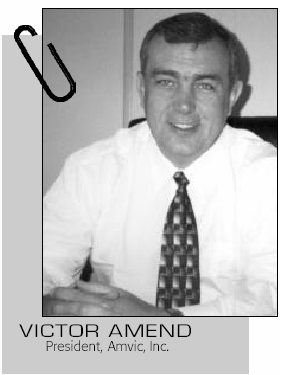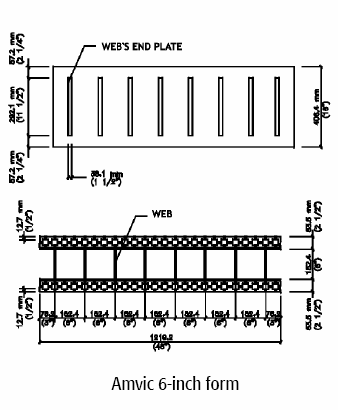



In three short years, Amvic has established itself as one of the top ICF suppliers in the world. Success has come through a product many consider the best on the market, even influencing the introduction of similar ICF systems from larger more established companies. At the same time, many in the industry criticize the company for riding the wave of many older ICF companies, namely recruiting away distributors at its low price/high volume strategy that took advantage of competitorsí marketing investments. The man behind it all is Victor Amend, the namesake of his company and product (two letters of his last name, three letters of his first name). We talked more with Mr. Amend about these issues and more.
ICF Monitor: Tell us about your background and how you got involved in the ICF industry?
Victor Amend: Iíve been in the construction industry since I got my degree in Civil Engineering back in 1981. I worked as a project manager for a large construction company (3000+ employees) overseeing the development of multi family, commercial, and industrial structures. I went back into academics earning a PhD and then serving as a lecturer. After that, I started several businesses related to the construction industry, including the manufacture of hardwood floors. I believe it was 1995 at a European trade show that I first saw ICFs. I saw the opportunity and it didnít take long for me to dive in. After several iterations, we came up with the Amvic Building System in 1998.
IM: You decided to start with your own manufacturing facility, which is unconventional. Then this year you outsourced your manufacturing by signing an agreement with a molder. Whatís the strategy behind these moves?
VA: In looking at the market in 1998, one of the most common complaints reported by contractors was the poor quality of ICFs. We believed that poor manufacturing contributed to this. It wasnít a coincidence that the majority of ICF companies outsourced their manufacturing to EPS molders, whose core
businesses most of the time were in packaging. The molding of an ICF is inherently different and to provide the highest quality product on the market, we were willing to invest in a manufacturing facility with the latest equipment. It was safer to go with a molder financially, but we weren't willing to risk the quality of the product.
This year, we partnered with Diversified
Plastics to manufacture and ship our products
to meet the growing demand and to reduce freight costs. The decision was made because the ICF market in 2001 is very different from
1998. First, you have a couple of large machine makers that have produced state-of the-art equipment specifically for ICFs. Second, you have molders that recognize ICFs as a growing market and have invested accordingly. Third, before we signed the deal, we conducted careful due diligence to ensure that our quality standards would be replicated.
We did everything possible, from ddemonstrations to a number of visits to their facilities, to ensure this. We also considered the quality of people working there and determined that it was the right decision. Itís worked out well enough that we have two more similar deals closing, one on the west coast and the other in the southeastern states.
IM: Many praise Amvic for its design and durability. How did the design come about?
VA: The original concept of the Amvic Building System came from a number of sources. We looked at the existing products out on the
market, we talked to a number of contractors, and we did a lot of thinking on our own. In designing the block, one important element we wanted to incorporate was strength, since ICFs must endure the immense pressures from pouring concrete. This led us to insert a tie every six inches, which is one of our most popular features. I donít think itís an exaggeration to say that our product is the strongest.
IM: Can you provide any information on new products in the works, either improvements to your existing line or completely new systems?
VA: We have two new ICF systems in the design stage. The first one will be introduced early next year and the second one will be towards the end of next year. These products will complement, not replace, the existing product line. Thatís all I can say at this point.
IM: Several ICF companies are incorporating some of the fundamental design concepts of Amvic to their new products. Although this might be flattering, are you concerned at all how these products might lessen your competitive advantage?
VA: Of course I donít like it, but thatís what competition is. We have filed a patent and weíre waiting for it to come through, which should happen very soon. Once we have the patent, we wonít hesitate to go after companies we feel are acting unscrupulously.
The quality, not the design of the product is Amvicís focus and our competitive advantage. The design might be easy to copy, but the quality isnít. Besides, as Iíve stated before, weíre working on some new products that should allow us to remain ahead of the competition.

IM: At the same time, many manufacturers consider a company like Amvic harmful to the market. They criticize you for coming into the market with a low priced product and taking advantage of all the marketing dollars they have spent on promoting ICFs. How do you respond?
VA: Thatís what competition is. We provide the best quality product at the best price. Itís good for the market and everyone benefits, except for companies that complain and do nothing about it. Iíll be the first to admit that
the marketing efforts of older companies helped us in the beginning, but we are now present at all the major trade shows, advertise in trade publications, have upgraded our web presence, and work closely with our distributors on regional marketing programs. Weíve recruited and trained contractors that have not worked in the industry before and won over customers in the residential and commercial markets that had never previously considered ICFs.
IM: Can you give us any indication of the volume Amvic has done since inception? Any specific markets youíre going after?
VA: For 2000, we increased our volume thirty times from 1999. This year weíll do three times what we did in 2000. Next year weíre projecting three times what we do this year.
We donít focus on a specific geographic market, nor are we making a concerted effort into the commercial sector like a lot of other ICF companies. We are looking more at the international markets, and youíll see us in Asia, Europe and Africa in the near future.
IM: What will separate Amvic from other ICF companies five years from now?
VA: Two descriptions will forever be associated with Amvic Building Systemóhigh quality and affordable price. If we maintain our edge there , the rest will take care of itself.
♦